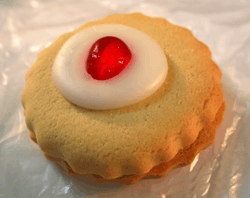Empire biscuit
| Empire biscuit | |
|---|---|
 | |
| Alternative names | Imperial biscuit, double biscuit, German biscuit, Linzer biscuit, Deutsch biscuit, Belgian biscuit |
| Type | Cake |
| Place of origin | United Kingdom |
| Region or state | Scotland |
| Main ingredients | Biscuits, jam in between two biscuits. The top is covered with white water icing, usually decorated with a glace cherry |
|
| |
An Empire biscuit (Imperial biscuit, Double biscuit, German biscuit, Belgian biscuit or Double Shortbread) is a sweet biscuit popular in the United Kingdom, particularly Scotland, and other Commonwealth countries. It is typically considered a traditional Scottish snack.[1]
History
The biscuit was originally known as the "Linzer Biscuit", and later the "Deutsch Biscuit". With the outbreak of World War I it was renamed to Empire biscuit, except in Northern Ireland where it remains known as the German Biscuit. In Northern Ireland it is commonly found with a jam and coconut topping. It is also known as the "Belgian biscuit", due to being topped in a similar way to a Belgian bun made of pastry or dough.
Ingredients
The typical Empire Biscuit has a layer of jam in between two biscuits, typically Shortbread. The top is covered with white water icing, usually decorated with a glace cherry in the centre, but Jelly Tots are common too. They are derived from the Austrian Linzer Torte.[2] The biscuit is smaller than the Linzer Torte and does not have a cut-out section on the top.
Similar Products
Empire biscuits are similar to Viennese Whirls.[3]
See also
- Liberty cabbage
- Freedom fries
References
- ↑ http://www.rampantscotland.com/recipes/blrecipe_empire.htm
- ↑ Edmonds Classics Hachette Livre, 2005. pg. 25
- ↑ http://www.tomharris.org.uk/2009/04/25/end-of-empire/
External links
- Review of biscuit on Nice Cup of Tea and a Sit Down